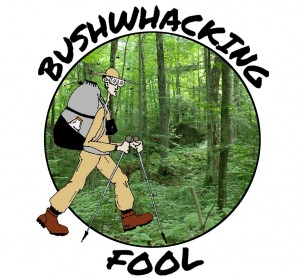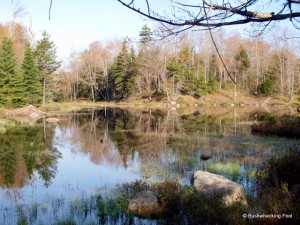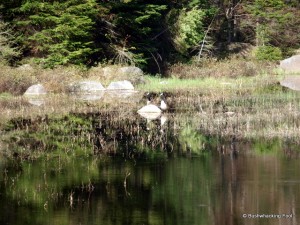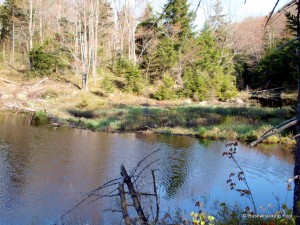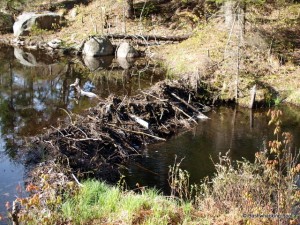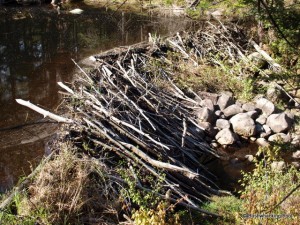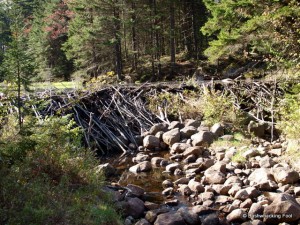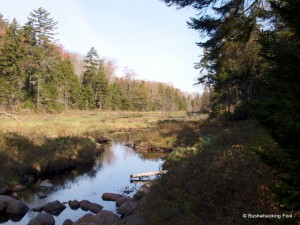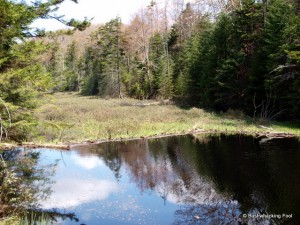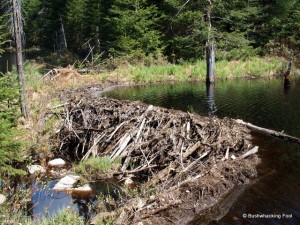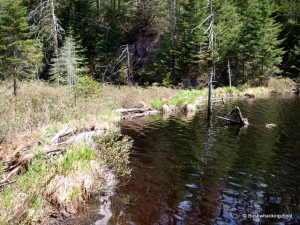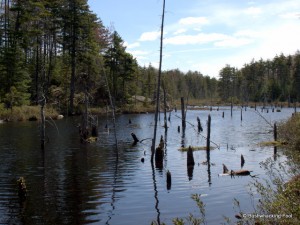Beavers. They ruined my Birdathon experience this year. Well, ruined may be strong a word, foiled is probably better.
Those industrious rodents are either boon or bane while birding (and bushwhacking) within Adirondack forests. Their ponds, created often by damming streams, provide ample habitat for many species of birds. Long after the beavers’ departure and subsequent burst dam, the meadows left behind also provide a unique habitat with its own avian community.
These beaver meadows were the crux of my Birdathon plans this year. Unfortunately, the beavers had their own idea.
It is not quite eight o’clock in the morning when I say my final good-byes to my Cropsey Pond home, where I spent the early morning accumulating a decent start to my Birdathon results with over 30 species. Following the shoreline, I bushwhack toward the outlet stream, which I plan on following almost all the way toward Moshier Creek before heading north toward the Deer Pond outlet. My goal is to reach the western shore of Raven Lake by early evening, but the late start this morning makes that less likely now. Perhaps the best I should hope for is the southern tip of Sunshine Pond.
View Birdathon 2013: Day Two, Part Two in a larger map
After weaving through the forest along the shoreline, I reach the end of Cropsey Pond, where I say another good-bye, as I most likely will not return until next year, if then. I notice a glistening sheen of pollen on the pond’s surface at its dammed outlet, reflecting the early morning sunshine. Although pretty, it fails to look the part of the crystal-clear mountain pond on this spring morning.
Section Stats:
Date: May 18, 2013
Length: 2.4 miles (2.5 total daily miles; 4.2 total trip miles)
Difficulty: Moderate
I cross the outlet stream on some rocks at the first opportunity, moving to the northern side of the stream and positioning myself for the eventual climb to the northeast. For now, the mountain stream remains my guide to the northwest where within a short time I expect to enter a large beaver meadow.
Unfortunately, the beavers were not complacent during my two-year absence from the area though. Instead of the expected meadow, a large beaver pond greets me as I emerge from the forest, where only two years ago there was a spectacular mud flat in the early stages of transforming into a pleasant beaver vly. There goes all chance of adding open area species or shorebirds to my burgeoning bird list.
And then, the honking begins.
Two extremely noisy and territorial Canada geese call this their home now, evident by the constant and persistent honking I endure from the moment of my emergence from the forest until I am well past the large beaver dam at the far end of the pond. At least all the racket gives me another species to add to my list.
Instead of making good time walking on level ground in the meadow that now lies under water, I contend myself with the constant up and down along the steep northern shoreline. The forest along its northern shore is mostly open, but steep, with frequent beaver spikes waiting to slash apart the shins of the unwary. I remind myself it is a good thing the thick herbaceous vegetation has not started growing yet.
The constant physical effort of climbing along the steep terrain, combined with the warming temperatures as the sun slowly inches its way higher in the sky, eventually make for a sticky morning even before reaching the pond’s beaver dam. The many layers of clothing do little to alleviate the sweltering situation either. It is nice to feel warm for the first time this morning, but I did not want to be soaked in sweat in the middle of May, especially while still recovering from a serious head cold. A quick change of clothes should help, although I remain hesitant to do so with the perverted geese continually watching me.
Along the beaver pond’s shoreline, I hear many different avian species, but unfortunately, all ones I already recorded for the day. A broad-winged hawk suddenly appears, flying to a tree overlooking the pond. Is this the same individual as I saw earlier, or its mate? Spring peepers continue their calling, although not as persistent as earlier in the morning.
When I finally approach the dam, I obviously pass some invisible threshold, as the constantly honking geese take flight, circling the pond several times before finally disappearing above the greening treetops. Their never-ending honking fades with their increasing distance, the relative quiet of the wilderness returning to the beaver pond.
This beaver pond is really a series of unending water bodies along a narrow valley, each separated by another by one or more beaver dams. Where once there was a series of meadows a few years ago, now there is nothing but open water as far as the eye can see through the valley. With the return of the industrious beaver, the pleasant meadows, once separated by burst dams, lie submerged under water, much to my consternation.
This is NOT going to help make up time I lost lingering at Cropsey Pond earlier in the morning.
The first dam is a long meandering thing, seemingly right at the water level, making it almost invisible as I walk past. Beyond the dam, on my side of the stream lies mostly open water, while the opposite side contains shrubbery and herbaceous vegetation mingled in with watery canals. Just beyond the shrubbery is another pool of open water ending at a smaller and more robust dam where the valley closes in.
It is as if this whole valley is a beaver’s idea of a water park.
While walking past the dam, I barely evade a pile of scat. Based on the plethora of hair and the shape, it appears as coyote, unless the gray wolf has miraculously reclaimed its historic territory unbeknownst to everyone else. As comforting as I may find that, I find it extremely unlikely. Roadrunner being unavailable this far north, the coyote must have been sniffing around for a beaver dinner, or maybe a noisy goose.
At a peninsula, I head up into the forest to cut over it rather than continuing to follow the shoreline. My sweaty armpits demand a quick clothing change, as I cannot go on much further, especially now that the geese moved on. Shedding the long johns and down jacket, I stuff the extra clothing down into my backpack, dancing about the entire time to avoid being an easy target for the growing horde of blood hungry black flies.
The valley continues northwest with one pond following another with an occasional dam in between them. At some points, the valley narrows, with hardly more than a stream flowing through, while at other locations it widens allowing for a sizable beaver pond.
Along the shoreline, I find an old, slightly crushed Adirondack soda can sticking out of the brown vegetation. Whether a torrent during the spring melt swept it up or some careless adventured dropped it here, I bend down and retrieve it, slipping it into one of my side pockets with my half-filled Platypus collapsible water bottle.
Finally, when the forest closes in on the valley, leaving nothing but a rocky, forested stream ahead, I climb the northern slope before the stream rounds a bend and heads south toward its ultimate destination of Moshier Creek (point BT13-010 on the accompanying Google map).
Now bushwhacking through mostly hardwood forest, I head east over a ridge to another series of, hopefully, more productive wetlands. Young American beech dominate the forest here, with an occasional older spruce and red maple mixed in. Many older beech snags remain, probably succumbing to beech bark disease or some other disorder. Ovenbirds, black-throated blue warblers and black-throated green warblers sing constantly as I pass through.
As I descend from the ridge top, the green frogs calling warn me of approaching the wetland. When I finally emerge from the forest, now thickly coniferous along the wetland’s edge, I find, once again to my surprise, that a perfectly good marshy wetland is now just another beaver pond with a scattering of drowning shrubs emerging from around its border.
Damn, foiled once again by those industrious rodents!
Any dream of finding Virginia rails or Soras at this wetland now dashed, I bushwhack along upstream to the south looking for a dam to cross on so I can continue north to Deer Pond’s outlet stream.
Unfortunately, I take a slight detour to head out onto a peninsula jutting out into disappointing wetland. From a previous Birdathon adventure, I recall a level area here with a nice view of the entire wetland. Crawling over some nasty downed conifers and weaving through some young spruce with dead limbs arrayed in such a way as to easily poke and prod me, I start to wonder whether the wetland has changed or my memory is faulty. Maybe two different wetlands remain juxtaposed in my brain, and the one I imagined is located somewhere else in the Adirondacks.
After extracting myself from the torture that is the peninsula, I continue bushwhacking upstream toward my eventual crossing. The stream remains wide enough to prove impossible to cross without a beaver dam, so I start watching out for one, regularly alternating between hiking in the forest and coming back to the stream to look up and down for a convenient crossing.
Unfortunately, the first beaver dam looks less than accommodating, so I continue onto the next one upstream. Unfortunately, the next one is no marvel of modern engineering either, but a quick peak upstream reveals a rather expansive wetland with a boggy shoreline, so I may have no other choice. After perusing the Stillwater topographical map, my worst fear becomes apparent, nothing but wetland from this point forward to almost reaching Raven Lake Road to the east.
My choices are limited. I either cross this dam, where I crossed in 2011, go back to a previous one or risk a rather long hike, well out of my way to the eat. Not much of a choice really. This beaver dam will have to do.
Despite the shabby appearance, the beaver dam is not overly difficult to cross, although its narrowness does generate a little trepidation (point BT13-013). A stiff breeze comes through while I am in the middle of the beaver dam, causing me to stop and look to the sky; luckily, no dark clouds are within sight, with the sky remaining mostly clear and blue.
Fortunately, beavers serve one good purpose, as they provide a means of crossing Adirondack streams. Otherwise, I would be getting wet much more often. Now all that remains is a climb up and over a broad ridge into the Deer Pond outlet watershed where I hope (and pray), to find more bird species before the day is done.
But that is a story for next time.
Affiliate Disclaimer: Some links within this blog post may send you to a retailer website. If you chose to purchase any product on that site at that time, this author receives a small commission. These commissions provide compensation for the author’s time and effort necessary to provide the content at the Bushwhacking Fool.
